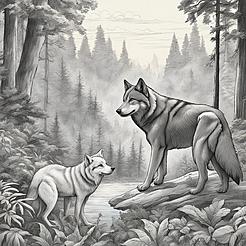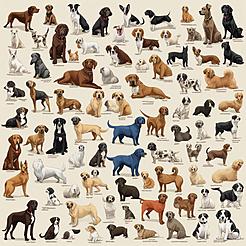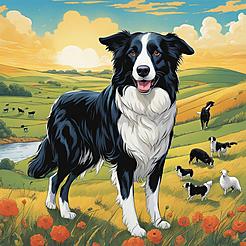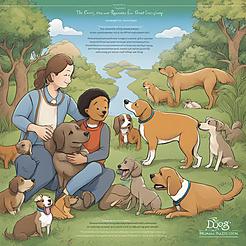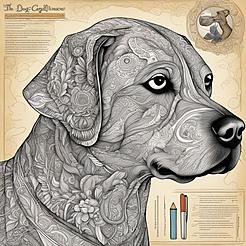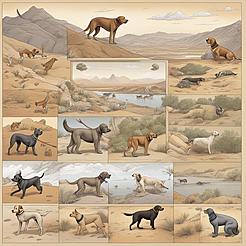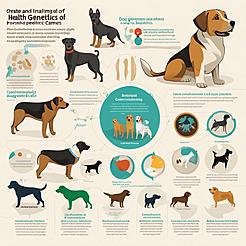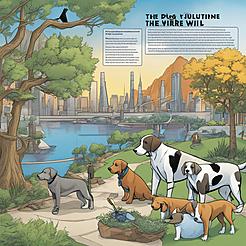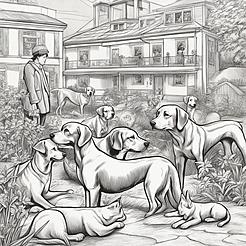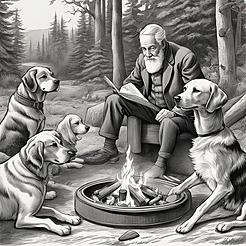 henrydjacob
henrydjacob- Chapter
- 2024-04-15

In the intricate tapestry of the dog's evolutionary journey, where the threads of human influence and the forces of natural selection intertwine, there lies a profound intersection where genetics and health converge to shape the very essence of our canine companions. As we delve into the chapter of "Health and Genetics of Canines," we embark on a riveting exploration of how selective breeding has left an indelible mark on the resilience and vulnerabilities of different dog breeds.
Genetics, the blueprint of life encoded in every strand of DNA, weaves a complex tapestry that dictates not only the physical characteristics of dogs but also influences their health and well-being. Through the lens of selective breeding, humans have wielded a powerful tool in sculpting the genetic landscape of dogs, shaping breeds to fulfill specific roles and exhibit desired traits.
One of the most striking manifestations of selective breeding can be observed in breeds that have been meticulously crafted for specialized tasks. Consider the Border Collie, a breed celebrated for its exceptional intelligence and herding instincts. Through generations of selective breeding aimed at enhancing their herding abilities, Border Collies have been endowed with sharp cognitive faculties and unparalleled agility, making them adept at navigating the intricate dynamics of livestock management. However, this intense focus on specific traits has also brought about genetic predispositions to certain health conditions, such as hip dysplasia and eye disorders, underscoring the delicate balance between form and function in the realm of selective breeding.
Conversely, breeds like the Poodle, known for their diverse sizes and hypoallergenic coats, exemplify the versatility that can be achieved through selective breeding. By carefully selecting for traits like coat texture and size, humans have crafted variations of the Poodle that cater to different preferences and practical needs. Yet, this diversity also comes with its own set of genetic considerations, with smaller Poodle variants often prone to dental issues and larger ones susceptible to joint problems, highlighting the intricate interplay between genetics and health in the realm of selective breeding.
The impact of selective breeding on canine health extends beyond physical traits to encompass a myriad of genetic predispositions that can influence a dog's overall well-being. Breeds like the Cavalier King Charles Spaniel, cherished for their affectionate nature and gentle demeanor, are unfortunately predisposed to heart conditions such as mitral valve disease due to genetic factors inherited through breeding practices. This poignant reminder underscores the ethical considerations that accompany the pursuit of breeding dogs for specific traits, necessitating a delicate balance between preserving breed standards and safeguarding canine health.
As we peer into the genetic tapestry of canines, we are confronted with a myriad of complexities that underscore the indelible link between genetics and health. The legacy of selective breeding serves as a double-edged sword, bestowing upon dogs both strengths and vulnerabilities that mirror the intricacies of their genetic makeup. Through this exploration, we are beckoned to reflect on the responsibilities that come with shaping the genetic destiny of our loyal companions, recognizing the enduring impact of our choices on their well-being.
In the chapters that have unfolded before us, we have journeyed through the annals of canine evolution, tracing the origins of dogs, exploring the influence of selective breeding, and unraveling the environmental adaptations that have shaped the diverse world of beloved breeds. Now, as we delve into the realm of health and genetics, we are poised to confront the intricate web of genetic destinies that intertwine with the health and resilience of different canine breeds.
Together, let us navigate the intricate terrain of genetics and health in canines, guided by the lessons of natural selection and the enduring bond that binds us with our faithful companions. In unraveling the genetic mysteries that underpin the health of dogs, we illuminate the path forward, where the legacy of selective breeding converges with the imperative of safeguarding the well-being of our canine counterparts.
References:
- Ostrander, Elaine A., and Anatoly Ruvinsky. "The Genetics of the Dog." CABI, 2012.
- Schoenebeck, Jeffrey J., and Elaine A. Ostrander. "The genetics of canine skull shape variation." Genetics 193.2 (2013): 317-325.
